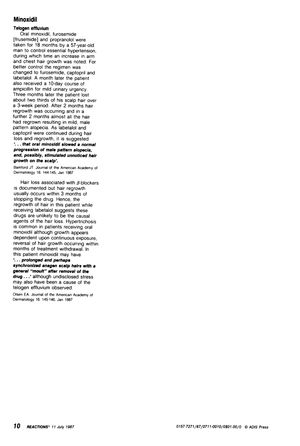Minoxidil
July 1987
in “
Reactions (Auckland)
”

TLDR Oral minoxidil may slow male pattern baldness and cause body hair growth, but hair loss can happen after stopping it.
In 1987, a case study reported a 57-year-old man who had been taking oral minoxidil along with furosemide and propranolol for 18 months to manage essential hypertension, during which he experienced increased arm and chest hair growth. After changing his medication regimen and a brief course of ampicillin, he lost about two-thirds of his scalp hair over three weeks. However, within four months, his hair regrew, resulting in mild male pattern alopecia. The continued use of labetalol and captopril during the period of hair loss and regrowth suggests that these drugs were unlikely to be the cause of the hair loss. The case suggests that oral minoxidil may have slowed the progression of male pattern alopecia and possibly stimulated unnoticed hair growth on the scalp. Hypertrichosis is a common side effect of oral minoxidil, but hair growth typically reverses after treatment cessation. The patient's hair regrowth while on labetalol indicates that beta-blockers are unlikely to be the cause of hair loss, as regrowth usually occurs within three months of stopping such drugs. The study also notes that the removal of minoxidil might have synchronized anagen scalp hairs, leading to a general shedding or "moult," although stress could also have contributed to the observed telogen effluvium.
